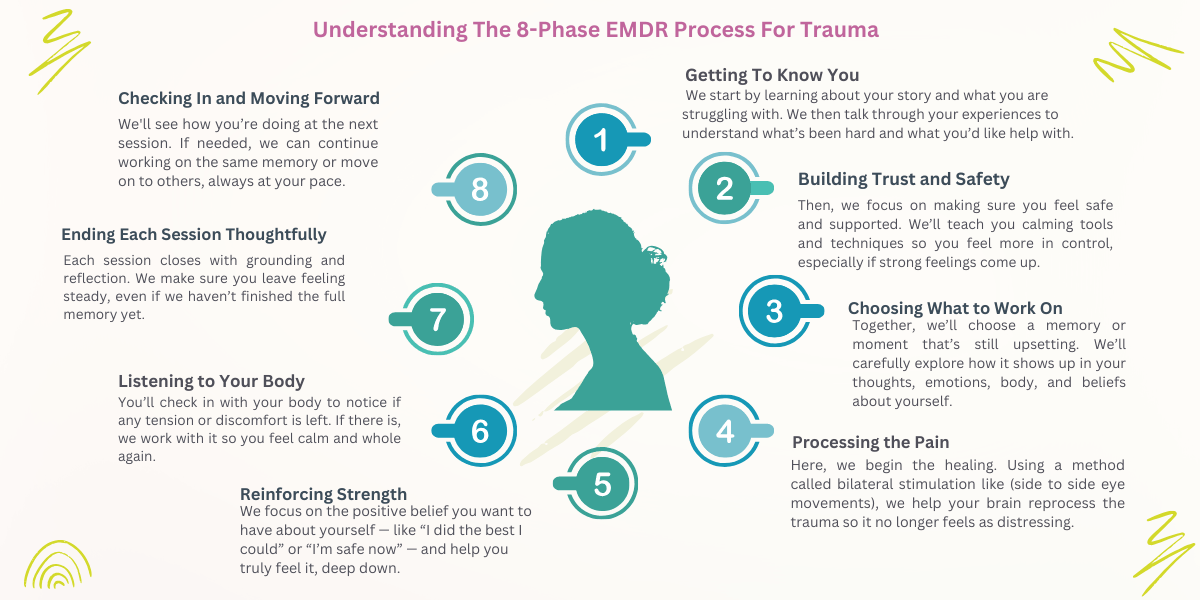Heal from Trauma with EMDR Therapy for Women in Seattle and Washington
Feel safe, supported, and seen as you begin your healing journey.

Overcoming Trauma with EMDR
Trauma may shape your story, but it doesn’t have to define your future.
EMDR (Eye Movement Desensitization and Reprocessing) is a proven, evidence-based therapy designed to help individuals process and recover from traumatic experiences. Whether you’re dealing with PTSD, anxiety, or distressing memories, EMDR can help restore your sense of peace and safety.


Even if talk therapy hasn’t fully helped — there is still a way forward.
When trauma lingers, it can feel like certain memories or emotional patterns are stuck in place. You might understand what happened, but still feel the weight of it in your body, your thoughts, or how you respond to the world around you. EMDR (Eye Movement Desensitization and Reprocessing) is a therapy that helps the brain and body process those stuck points — gently, safely, and at your pace.
Who Is EMDR For?
EMDR may be beneficial if you:
- Experience lingering effects from past trauma or loss.
- Have found limited relief from traditional talk therapy.
- Feel trapped in cycles of fear, shame, or disconnection.
- Desire change without re-experiencing traumatic events.
If any part of this feels familiar, it may be time to try something different. EMDR offers a safe space to heal at your own pace.

Special Focus Areas I Work With:
- Abuse (emotional, physical, sexual)
- Birth trauma and postpartum PTSD (including unplanned interventions,
- NICU stays, or feeling unsupported during labor)
- Medical trauma
- Grief and loss
- Accidents and injuries
- Childhood trauma and neglect
- Witnessing violence
- And more…..
Birth Trauma & Motherhood
Is This You After Birth?
Even when everyone says you and your baby are “fine,” the emotional impact of a difficult or traumatic birth can linger quietly — and painfully. Birth trauma isn’t always about what happened medically. It’s about how the experience made you feel: powerless, afraid, unseen, or overwhelmed.
You might be experiencing birth-related trauma if:
- You replay the birth and feel panic, regret, or sadness
- You avoid thinking or talking about your delivery
- You feel guilt or shame about how things went
- You struggle to bond with your baby or feel emotionally numb
- You believe your body failed you — or that you failed as a mother
EMDR can help process these painful emotions, allowing you to reclaim your narrative of motherhood.
How EMDR Facilitates Healing
The goal of EMDR is to help your brain reprocess distressing memories so they no longer feel raw, overwhelming, or “stuck in time.”
When something traumatic happens, your nervous system shifts into survival mode (fight, flight, freeze). Sometimes, the brain doesn’t fully process the memory, and it gets “frozen,” causing symptoms long after the event.
Through EMDR, we use gentle bilateral stimulation (like eye movements or tapping) to activate your brain’s natural processing system. This helps integrate the memory without re-experiencing the trauma, so it can lose its emotional charge.
“Changing the memories that form the way we see ourselves also changes the way we view others, our relationships, and the world.” — Francine Shapiro, EMDR founder
What Happens in EMDR Therapy?
EMDR therapy follows a structured, eight-phase process designed to help your brain reprocess traumatic memories so they no longer feel overwhelming or stuck. Each phase plays an important role in supporting your healing journey — from building safety and trust to gently desensitizing distressing memories and reinforcing your strengths.
Whether you’re new to EMDR or just curious about what to expect, here’s a breakdown of how we move through the process together — at your pace, and always with care.
The EMDR Treatment Process ?
The Eight Phases Of EMDR
Phase 1 – History Gathering and Treatment Planning
We will begin by gathering information to understand your history, and develop a treatment plan during the first treatment stage.
Phase 2 – Preparations
In preparation for EMDR, you will learn about the impact of trauma on your life, body, emotions, and relationships. You will get to know EMDR, how it works, and what to expect during and after treatment.
Next, you will gain some new coping skills to help you feel more grounded and present, ready for EMDR.
Phase 3 – Assessment
During this phase, you will identify the “target” or the upsetting memory you want to work on, including any negative thoughts, body sensations, or feelings that go with the memory. At this point, you will also identify what you want to believe about yourself as a healthy adult now.
At the end of the process, the goal is that this healthy belief will surface when you think back to what happened to you.
Phases 4 to 6 – Desensitization
This phase is the beginning of the reprocessing of your trauma.
This is where the eye-movement modality of EMDR comes into play, known as bilateral stimulation or “BLS.” BLS has been proven to enhance memory processing. While engaging in BLS, you focus on the trauma’s visual image, a negative thought you hold about yourself from the time of the trauma, and the bodily sensations you are aware of. BLS processing means dealing with the disturbing feelings in a new and more comprehensive way.
Through EMDR, your brain can more fully process the data, including what has happened to you and emotions associated with the memory. Seeing the trauma from this new vantage point can enable you to make sense of what happened with updated information, leading to insights and a deeper level of self-compassion. The former distress related to the traumatic memory dissipates as you process the memory. In this way, EMDR enables you to finally heal.
Phases 7 and 8
During these final two stages, we make sure you feel stable and safe moving forward, and evaluate the progress you have made. Successful treatment means affective distress (your emotional pain) is relieved, negative beliefs (trauma-based thinking patterns) are re-formulated and physiological arousal (your body’s response to trauma) resolves. You remember your traumatic experience without the original fight, flight, or freeze response.
There is no right or wrong way to do EMDR and no prior skill is needed.
Each person processes information differently.
“The goal of EMDR therapy is to leave you with the emotions, understanding, and perspectives that will lead to healthy and useful behaviors and interactions.”

You Don’t Have to Be “Ready” to Heal
Many people hesitate to start trauma therapy, wondering:
- “What if I’m not ready to talk about it?”
- “What if it wasn’t ‘bad enough’ to count as trauma?”
- “What if I fall apart?”
These thoughts are normal. Trauma often makes us feel like we have to protect ourselves from revisiting the pain. But healing can begin gently, without having to relive everything. EMDR allows us to work with your brain’s natural healing capacity — safely and at your pace.
If something inside you is hoping for change, that’s enough. We can start there.
What Clients have said about EMDR:
I can think back about what happened to me, but the memory is no longer alive.”
I used to have to worry all the time about something triggering me and feeling upset. Now, I don’t even think about triggers anymore.”
I thought about what happened to me every single day for 20 years. Now, I don’t even think about it unless I want to.”
I used to believe that I caused what happened to me. I now understand that it was not my fault.”
Thanks to EMDR, I feel like I have a whole different future.”
5 Frequently Asked Questions About EMDR
- How long does EMDR therapy take?The length of EMDR treatment varies for each person. It depends on your goals, life history, and how your mind and body respond to the process. Some people feel relief quickly, while others need more time to work through deeper or more complex experiences.
- What affects how many sessions I’ll need? Factors include the number of traumatic experiences you want to address, the severity and duration of those experiences, your current level of safety and support, and your emotional readiness. We’ll move at a pace that feels right for you
- Can I still benefit from EMDR if I’ve already tried talk therapy? Absolutely. Many clients who found limited relief with traditional therapy find EMDR helpful—especially when they don’t want to rehash every detail of their trauma. EMDR works with the brain’s natural healing ability to shift distressing memories.
- Do I need to come into an office for EMDR? No. I offer secure, HIPAA-compliant virtual EMDR sessions for clients across Washington. Whether you’re at home, in a quiet office, or elsewhere, online EMDR is an effective and flexible option for healing.
- Is online EMDR really as effective as in-person? Yes. Many clients who’ve tried both formats report that virtual EMDR is just as effective—and sometimes even more comfortable—because they can do the work in a familiar, private space. It’s especially helpful for those with busy schedules or limited access to care.
Changing the memories that form the way we see ourselves also changes the way we view others. Therefore, our relationships, job performance, what we are willing to do or are able to resist, all move in a positive direction.
Compassionate Support, Backed by Experience
Healing from trauma is deeply personal—and so is the support you deserve.
I’ve spent over two decades helping women navigate their trauma recovery journeys with care, skill, and deep compassion. I’m not just trained in EMDR; I’m committed to walking beside you with warmth and attunement, creating a safe space for you to be seen, heard, and truly supported.
Whether you’re struggling with birth trauma, anxiety, or painful memories that still live in your body, I’m here to help you move gently toward healing—at a pace that feels right for you.
Together, we’ll work to quiet the distress, reconnect with your inner strength, and build a future where your past no longer defines your present.
You’re not alone—and you don’t have to do this by yourself anymore.

Ready to Feel More Like Yourself Again? EMDR Can Help.
🌿 Resources & Support
Whether you’re looking to learn more about EMDR therapy or seeking immediate support, the following trusted resources are here to help:
1. EMDR International Association (EMDRIA)
🔗 https://www.emdria.org
2. The National Center for PTSD – EMDR Overview
🔗https://https://www.ptsd.va.gov/understand_tx/emdr.asp
3. Trauma Recovery / EMDR Humanitarian Assistance Programs🔗 https://www.emdrhap.org
Crisis Support
If you are in emotional distress or need immediate help, you’re not alone.
988 Suicide & Crisis Lifeline
Free, confidential support 24/7 for anyone in the U.S.
Call or text 988 or visit:
🔗 https://988lifeline.org
Relevant Articles by Iris Hogan
Healing Birth Trauma with EMDR | Postpartum PTSD Support for Moms
Experiencing birth trauma can leave lasting emotional wounds—but healing is possible. EMDR therapy is a gentle, research-backed approach that helps mothers process and recover from postpartum PTSD. Whether your trauma is fresh or years old, EMDR offers a path to peace without reliving every painful detail.
Eco-Anxiety: What is It and Why Do People Experience It?
Discover what eco-anxiety is, why it occurs, and the signs to look out for. Learn what you can do to cope with it and manage it better.
What Does Undiagnosed PTSD Look Like?
Undiagnosed PTSD can have significant negative impacts on your life. Recognize the symptoms and learn what to do about it.



